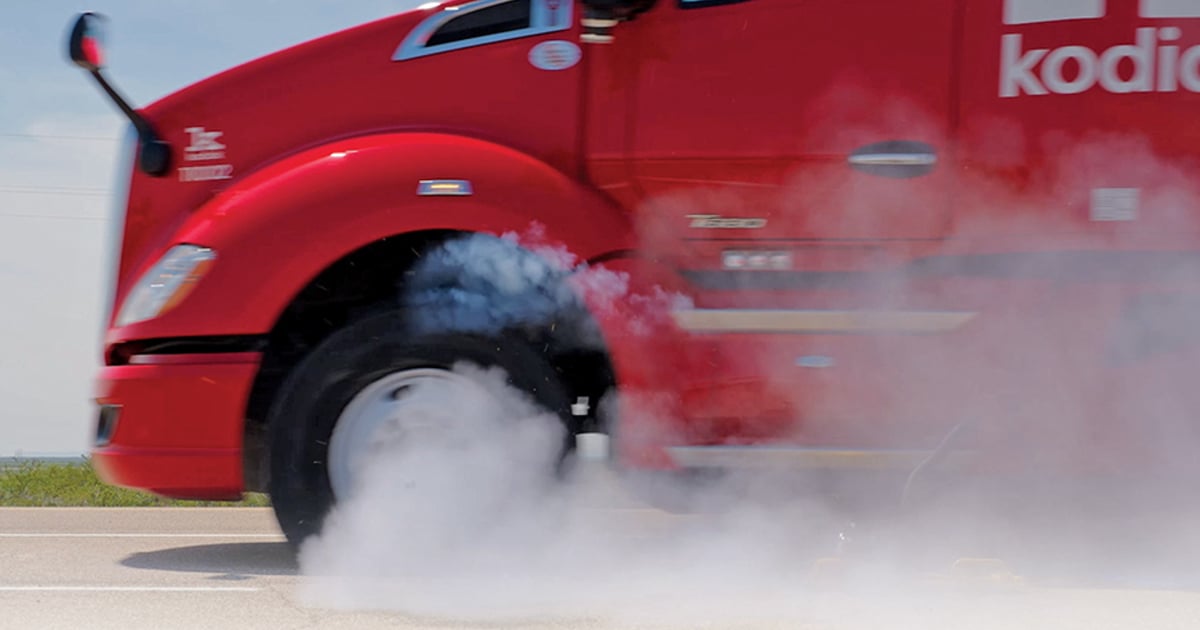
MOUNTAIN VIEW, Calif. — Training self-driving vehicles to handle unexpected situations is one of the biggest challenges to commercialization.
Autonomous technology companies frequently showcase how their self-driving software responds to unusual events and edge cases in general traffic, but few demonstrate what happens when something is physically amiss with the autonomous vehicle itself.
Flat tires, for example, can result in catastrophic consequences for self-driving trucks. At highway speeds, big rigs can be difficult to control when one of the tires they used for steering suffers a blowout.
That’s one safety skill Kodiak Robotics Inc., a self-driving trucking startup, has been refining and demonstrating in closed-course testing. The company recently showed video from a test in which one of its Class 8 tractor-trailers driving at 35 mph runs over a device designed to puncture tires.
Within microseconds, it responds to the driver-side tire puncture by applying a steering-wheel angle change that maintains the truck’s lane of travel.
“These are really hard to control, and demonstrating the ability of our autonomous driver to not only recognize the blowout in a fraction of a second, but then be able to safely handle it, is something that’s foundational to being able to launch autonomous vehicles,” Jordan Coleman, vice president of policy at Kodiak, told Automotive News.
Kodiak’s truck stopped within its lane of travel during the closed-course testing at a private facility in Texas. If the blown-tire scenario had occurred on a public highway, the truck would have reacted to the blowout, then safely maneuvered to the road’s shoulder, company spokesman Daniel Goff said.
Crashes involving big trucks account for approximately 5,000 deaths and 147,000 injuries in the U.S. annually, according to the Truck Safety Coalition. Faulty wheels and tires are the leading cause of equipment-related crashes, according to a 2015 study issued by NHTSA.
While a number of long-haul, self-driving trucking companies intend to begin driverless commercial service as early as 2024, few have spotlighted how their robotrucks will respond to system faults.
Kodiak stands as an exception. Earlier this year, the company showed how one of its trucks reacted when an ethernet cable that supplied information to its self-driving system was cut. In that case, the Kodiak truck pulled to the shoulder along Interstate 45. It marked the first time a self-driving truck company demonstrated such capability; competitors like Aurora soon followed.
The ability to respond to a tire blowout, a cut cable or dozens of other potential malfunctions starts with the architecture of the technology’s fallback systems.
Kodiak’s self-driving system monitors for such faults 10 times per second. Engineers built the controller, which is responsible for actuating the truck and executing path planning, on a custom safety computer built to automotive-grade standards. Each Kodiak truck carries two controllers for redundancy.
Fallback systems should rarely be used but always be available, says Kodiak CEO Don Burnette.
“We can’t control the hazards trucks will face on the open road, but we can control how the trucks behave when a critical situation occurs,” he said.
Understanding how trucks behave in blown-tire scenarios is difficult to simulate because of variability in conditions and payload, Burnette said. That makes data collected from closed-course testing valuable.
For example, having information from the real-world 35-mph test helped Kodiak more accurately simulate what would happen in a 65-mph test. The truck still maintains its lane of travel.
Still, that data can be arduous to collect. It took Kodiak’s engineering team more than a year to prepare for the testing to ensure its system was ready. Even for closed-course tests, the preparation underscored a basic tenet.
“We might not always do the right thing in terms of getting things from Point A to Point B, but it’s about showing we’re always going to do the safe thing,” Coleman said.
“No matter what happens, we’re going to do something safe and protect motorists around the trucks. That’s the bar for launch.”